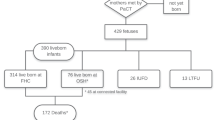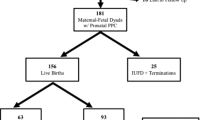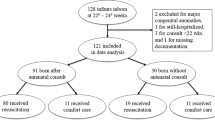Abstract
The changing environment in neonatology and perinatology has led to the examination of issues surrounding palliative care. Newborn palliative care should be considered in three general areas: (1) Neonates at the limits of viability. As advances in technology and outcomes become available, it is the responsibility of the health-care community and society to reach a consensus regarding the limits of viability. (2) Neonates with lethal congenital anomalies. When appropriate, and diagnosis and prognosis are certain, why should a family be deprived the opportunity to choose palliative care for the unborn child? (3) Neonates not responsive to aggressive medical management where continuing therapy may prolong suffering and postpone death. The question ‘Are you doing for the neonate or to the neonate?’ should be asked. These complex issues, along with best interest issues, site, mode and timing of delivery, and the development of palliative care are the subject of this manuscript.
This is a preview of subscription content, access via your institution
Access options
Subscribe to this journal
Receive 12 print issues and online access
$259.00 per year
only $21.58 per issue
Buy this article
- Purchase on Springer Link
- Instant access to full article PDF
Prices may be subject to local taxes which are calculated during checkout
Similar content being viewed by others
References
Martin JA, Kochanek KD, Strobino DM, Guyer B, MacDorman MF . Annual summary of vital statistics-2003. Pediatrics 2004; 115: 619–634.
Leuthner SR . Fetal palliative care. Clin Perinatol 2004; 31: 649–665.
AAP committee on bioethics. Fetal therapy-ethical consideration. Pediatrics 1999; 103: 1061–1063.
Carter BS, Bhatia J . Comfort/palliative care guidelines for neonatal practice: development and implementation in an academic medical center. J Perinatol 2001; 21: 279–283.
Catlin AJ, Carter BS . Creation of a neonatal end of life palliative care protocol. J Perinatol 2002; 22: 184–195.
Yellin PB, Fleischman AR . DNR in the DR? J Perinatol 1995; 15: 232–236.
MacDonald H . American Academy of Pediatrics. Committee of fetus and newborn: perinatal care at the threshold of viability. Pediatrics 2002; 110: 1024–1027.
Hussain N, Rosenkrantz TS . Ethical considerations in the management of infants born at extremely low gestational age. Sem Perinatol 2003; 27: 458–470.
Jeanty P . Fetal biometry In: Fleischner AL, Manning FA, Jeanty P, Romero R (eds.) Sonography in Obstetrics and Gynecology: Principles and Practice, 5th edn. Appleton & Lange: Connecticut, 1996, pp. 137–139.
Kohn MA, Vosti CL, Lezotte D, Jones RH . Optimal gestational age and birth-weight specific cutoffs to predict neonatal morbidity. Med Decis Making 2000; 20: 369–376.
Dunn PM, Stirrat GM . Capable of being born alive? Lancet 1996; 1: 553–555.
Rennie JM . Perinatal management at the lower margin of viability. Arch Dis Child Fetal Neonatal Ed 1996; 74: F214–F218.
Peerzada JM, Richardson DK, Burns JP . Delivery-room decision making at the threshold of viability. J Pediatr 2004; 145: 492–498.
Meadow W, Reimshisel T, Lantos J . Birthweight-specific mortality for extremely low birth weight infants vanishes by four days of life: epidemiology and ethics in the neonatal intensive care unit. Pediatrics 1996; 97: 578–586.
Singh J, Lantos J, Meadows W . End-of-life after birth: death and dying in a neonatal intensive care unit. Pediatrics 2004; 114: 1620–1626.
Loveland, Cook CA, Flick LH, Homan SM, Campbell C, McSweeny M et al. Post-traumatic stress disorder in pregnancy: prevalence, risk factors, and treatment. Obstet Gynecol 2004; 103: 710–717.
Author information
Authors and Affiliations
Corresponding author
Rights and permissions
About this article
Cite this article
Bhatia, J. Palliative care in the fetus and newborn. J Perinatol 26 (Suppl 1), S24–S26 (2006). https://doi.org/10.1038/sj.jp.7211468
Published:
Issue Date:
DOI: https://doi.org/10.1038/sj.jp.7211468
Keywords
This article is cited by
-
Recommendations for palliative and bereavement care in the NICU: a family-centered integrative approach
Journal of Perinatology (2015)
-
Neonatal outcomes of fetuses diagnosed with life-limiting conditions when individualized comfort measures are proposed
Journal of Perinatology (2014)
-
Is ‘comfort’ care a ‘medical’ care? Observations on a neonatal population
Journal of Medicine and the Person (2012)



